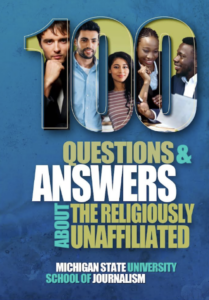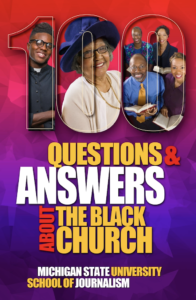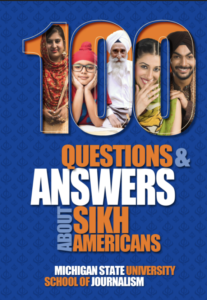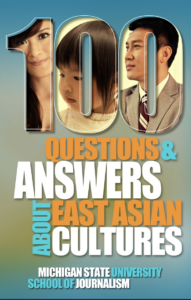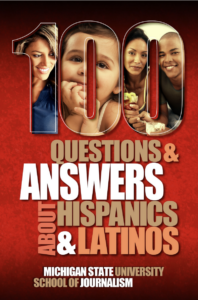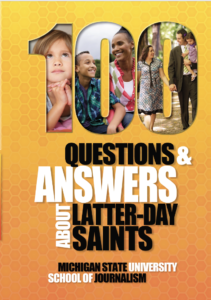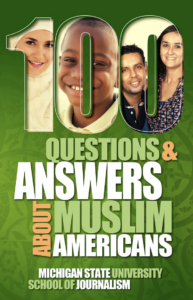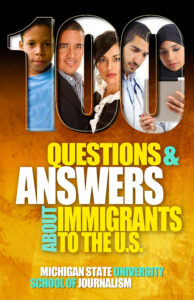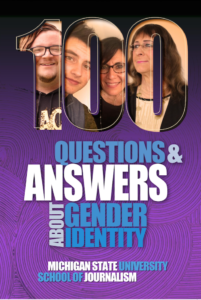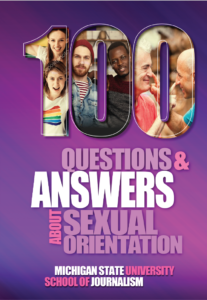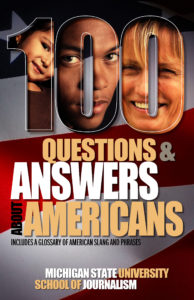These items are from “100 Questions and Answers About Sexual Orientation.” You can get all 100 answers in print or digital format.
How many sexual orientations are there?
Does everyone fit into a category?
Is sexual orientation determined before birth?
What percentage of Americans are lesbian, gay or bi?
ow accepted are lesbian, gay and bisexual people?
What does it mean to “come out?”
What does it mean to be “in the closet?”
On average, at what age do people come out?
What does it mean to “out” someone?
As parents, do same-sex couples have a “mom” and a “dad?”
Is it harmful for children to have parents of the same sex?
hat is the suicide attempt rate among lesbian, gay and bisexual youth?
Are gay students bullied more than others?
Can LGBTQ+ people serve in the U.S. military?
What is marriage equality?
What was the Defense of Marriage Act?
hat is the First Amendment Defense Act?
Are LGBTQ+ people more likely than others to prey on children?
Why do some people question whether bisexuality is legitimate?
What is bisexual erasure?
How many sexual orientations are there?
Sexual orientations include but are not limited to asexual, pansexual, lesbian, bisexual, gay, heterosexual, demisexual, homosexual and skoliosexual. The English language is fluid, with new identifiers arising and previous ones changing all the time. This area is one of rapid change right now.
Back to top | To order
Does everyone fit into a category?
Not everyone finds a specific category that suits them, so new terms are being introduced. Some people are moving away from identifiers or labels altogether. Labels can seem to set categories for life, which is not always the reality. People who are discovering their sexuality or identity sometimes describe themselves as “questioning.”
Back to top | To order
Is sexual orientation determined before birth?
Researchers at Johns Hopkins University found little evidence of a biological explanation for sexual orientation. More research is needed to clarify environmental factors. A University of Utah researcher reports that, for some people, sexual orientation changes. According to research by Dr. Lisa Diamond, 10 to 14 percent of women and 6 to 9 percent of men experience changes in sexual orientation.
Back to top | To order
What percentage of Americans are lesbian, gay or bi?
An estimated 10 million people in the United States identify as LGBTQ+, according to a 2016 survey by the Gallup polling organization. That’s just a little more than 4 percent of the population. But reluctance to identify oneself in these ways may result in an undercount. Researchers at the UCLA School of Law’s Williams Institute have found that people in the United States are more likely to say they have experienced same-sex attraction or activity than to use a label. Many factors can affect the ways and willingness of people to disclose their sexual orientations. Those include how safe and comfortable they feel doing so. The U.S. Census Bureau told Congress the 2020 count would begin asking couples if they were “same-sex” or “opposite- sex.” The bureau soon retracted that plan.
Back to top | To order
How accepted are lesbian, gay and bisexual people?
Acceptance is growing. In 2016 the nonpartisan Pew Research Center reported that 63 percent of U.S. adults said society should accept homosexuality. Twenty-eight percent disagreed. This varies among religious and political groups. On the issue of same- sex marriage, Pew reported that 62 percent of U.S. adults were accepting and 32 percent were opposed in 2017. That was a reversal from 2001 when 57 percent opposed same-sex marriage and 35 percent were accepting. The balance tipped in 2011.
Back to top | To order
What does it mean to “come out?”
This means to accept one’s own marginalized sexual orientation and to then tell others. Coming out usually occurs in stages. People often come out to friends first, then family, then classmates, coworkers or peers. The order depends on whom the person is most comfortable telling. The process never really ends because people must decide whether to come out when they make new friends or change jobs or schools. Increasing visibility of others who share one’s identity can make coming out easier.
Back to top | To order
What does it mean to be “in the closet?”
Someone who is closeted has not yet disclosed their sexual orientation. It is possible to be out with some people but closeted with others. Some people who have a bad experience coming out might go back to being closeted.
Back to top | To order
On average, at what age do people come out?
The average age is 14 to 16, according to San Francisco University’s Family Acceptance Project. This is younger than in the 1970s, when the average age was the early to mid-20s.
Back to top | To order
What does it mean to “out” someone?
Outing is to reveal someone else’s orientation before that individual is ready to come out. Outing can occur after the individual has already come out, but not publicly or to everyone. People out others in gossip, out of malice or ignorance. Outing has also been done by other LGBTQ+ people who believe others should come out, too. Sometimes they are looking for support. Outing occasionally has been very public. For instance, some gay politicians who professed to be anti-gay have been outed by people trying to expose hypocrisy.
Back to top | To order
As parents, do same-sex couples have a “mom” and a “dad?”
Same-sex couples with children need not have a designated “mom” and “dad,” just as they need not designate one “wife” and one “husband.” Many same- sex couples refer to themselves as two husbands or two wives. The fact that one partner calls the other his husband does not mean that he is not also a husband. So, some families have two moms or two dads. It’s best to ask or listen for conversational cues.
Back to top | To order
Is it harmful for children to have parents of the same sex?
Seventy-nine studies have found that children of gay or lesbian parents do as well as children in other kinds of families. The findings come from a Columbia Law School review of scholarly research through 2017. It concurred with a 2016 study in the Journal of Developmental and Behavioral Health concurred. This study found that children of same- sex parents are as emotionally and physically healthy as children of different-sex parents. They can be more likely to talk about emotionally difficult topics and are often more resilient, compassionate and tolerant. This is from the American Association for Marriage and Family Therapy.
Back to top | To order
What is the suicide attempt rate among lesbian, gay and bisexual youth?
According to the 2015 National Youth Risk Behavior Survey, 34.9 percent of gay, lesbian, bisexual or questioning students were planning suicide. Almost 25 percent had attempted it in the previous year. Of straight teens in the study, 11.9 percent said they had been planning suicide, and 6.3 percent said they had tried it in the prior year. A study in the Journal of the American Medical Association found that suicide rates went down when states allowed same-sex marriage.
Back to top | To order
Are gay students bullied more than others?
According to GLSEN’s 2015 National School Climate Survey, 85.2 percent of LGBTQ+ students said they had been verbally bullied. Nearly 35 percent of them reported physical bullying. Almost 49 percent experienced cyberbullying. Students in the survey said anti-bullying education helps, especially when it specifically addresses LGBTQ+ bullying. For comparison, the National Center for Educational Statistics reported in 2016 that 20.8 percent of students in the general population said they had been bullied.
Back to top | To order
Can LGBTQ+ people serve in the U.S. military?
Yes, and they do. LGBTQ+ people serve in the armed forces in many countries. In the U.S. military, they were banned into the 21st century, but President Barack Obama in 2011 repealed the ban on openly gay people serving. The debate today is primarily about transgender people, not gay, lesbian or bisexual people. The “don’t ask, don’t tell” policy barred people who were openly gay from serving in the U.S. armed forces. The policy allowed the military to discharge individuals who came out. The Clinton administration enacted it in 1994. It was meant to allow gay people to remain in the military but to protect them from being asked about their sexual orientation and prevent them from disclosing it. When President Obama signed the repeal of the policy, he said it had forced gay and lesbian military personnel to lie about their identities and sanctioned closeting.
Back to top | To order
What is marriage equality?
Marriage equality is legal recognition of same-sex marriage. On June 26, 2015, the U.S. Supreme Court ruled in favor of same-sex marriage nationwide. That established marriage equality in the United States. Just one month before the ruling, 72 percent of Americans surveyed had told Pew that legal recognition of same-sex marriage was inevitable. However, national LGBTQ+ protections don’t extend to other rights, so social justice work is ongoing.
Back to top | To order
What was the Defense of Marriage Act?
The Clinton administration implemented the Defense of Marriage Act in 1996. It limited marriage to one man and one woman. It said states did not have to recognize same-sex marriages recognized by other states. It also said the federal government was not bound by states’ legal recognition of same-sex marriages. In 2013, the U.S. Supreme Court ruled that the government could not discriminate against same-sex married couples in determining federal benefits and protections.
Back to top | To order
What is the First Amendment Defense Act?
This act was first introduced in Congress in 2015. The bill is designed to protect individuals and corporations who say their religious beliefs require them to refuse to serve LGBTQ+ individuals. Those beliefs could lead them to deny service based on clients’ sexual orientation and gender identity. In 2018, on a 7-2 vote, the U.S. Supreme Court ruled in favor of a Colorado baker who said his Christian convictions prevented him from baking a wedding cake for a same-sex couple. The court ruled that Colorado’s civil rights commission had downplayed the baker’s religious rights. The ruling was narrowly focused and
not about the larger issue of whether services may be denied.
Back to top | To order
Are LGBTQ+ people more likely than others to prey on children?
According to the American Psychological Association, children are not more likely to be molested by LGBTQ+ people. The finding was confirmed by University of California professor Gregory Herek. His review of various studies found no evidence that gay people molest children more than heterosexual people do. The Child Molestation Research & Prevention Institute found that most predators are men married to women.
Back to top | To order
Why do some people question whether bisexuality is legitimate?
Bisexuality challenges people’s thinking. One way to deal with that is to believe it does not exist. A study presented at the 2013 meeting of the American Public Health Association showed that 15 percent of people were skeptical. They believed bisexual people were confused or transitioning. However, American Institute of Bisexuality President John Sylla said research “completely validates that bisexual people exist.” Furthermore, a Williams Institute analysis of national surveys shows that the number of bisexual people is larger than the number who identify as gay or lesbian. However, stigmas including denial
among both straight and gay people discourage bi people from disclosing and can make them feel delegitimized.
Back to top | To order
What is bisexual erasure?
Bisexual erasure is when the legitimacy or existence of bisexuality is questioned or denied, according to GLAAD. Also called bisexual invisibility, erasure can contribute to reduced access to resources and support. Erasure can make bisexuals feel like they aren’t important or don’t exist. Bisexuality Visibility Day, first observed in 1999, was a response to marginalization of bisexual people in both the straight and broader LGBT communities. A study by Dr. Gilbert Gonzales published in the Journal of the American Medical Association reported that, “Bisexual people are not only marginalized by the larger heterosexual population, but also some bisexual individuals may experience stigma from gay and lesbian individuals, resulting in lower connections with the sexual minority community. … This ostracizing may lead to social isolation, a risk factor for psychological distress.”
Back to top | To order


